Workflow in Mozilla when creating the Save for Later feature for Firefox
This article describes in detail and with photos a process that is usually hidden from us: a study of user actions when working with a browser. It was conducted to develop a new Firefox feature - “Save for Later”, which allows you to save content for reading or viewing later. Also shown is a bit of workflow and brainstorming in Mozilla.
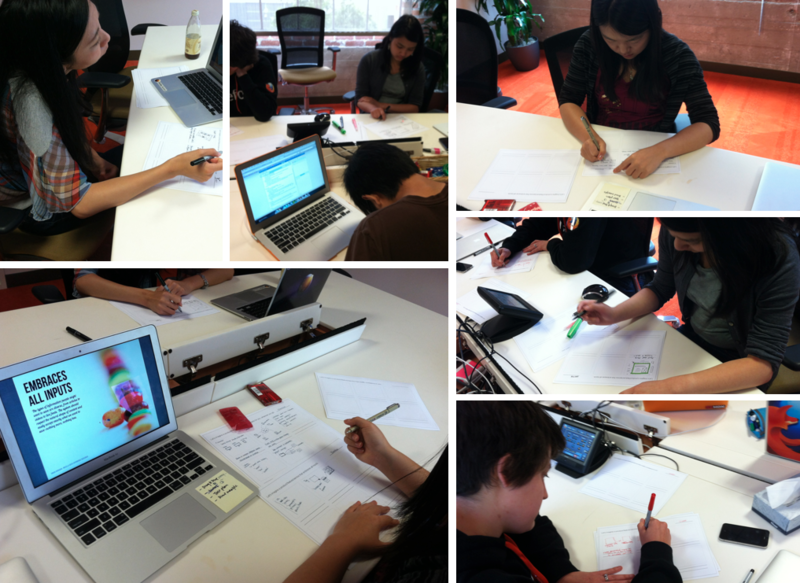
The browser has essentially two main functions: search (surfing) and re-visit. My task was to organize the bookmarks in such a way that the re-visit was the most simple and convenient. In developing the Save for Later feature, I worked closely with the Mozilla team, including front-end developers and product managers. 9 week development schedule:
')

Initially, a request for research from Firefox came to the Android team: why bookmarks are rarely used on mobile devices, and how much the popularity of this feature has grown, if it was implemented differently.
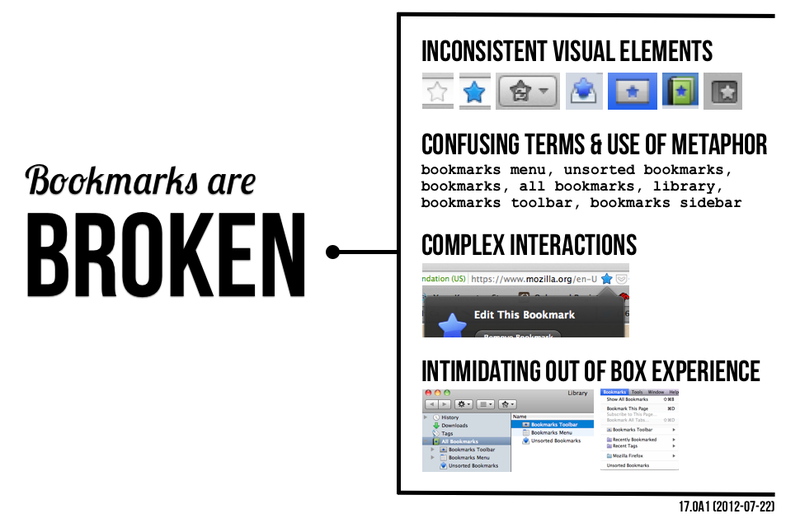
After a close look at the bookmarks in Firefox, it was clear that the function was implemented too difficult and should be simplified. It was also important to understand what today means “bookmark” for the user, and what options he would like to see.

As a result, it was concluded that the main purpose of the bookmarks is the function “Read later”.
Of the 60 people, 10 were selected to participate in the study. All were asked profiles:
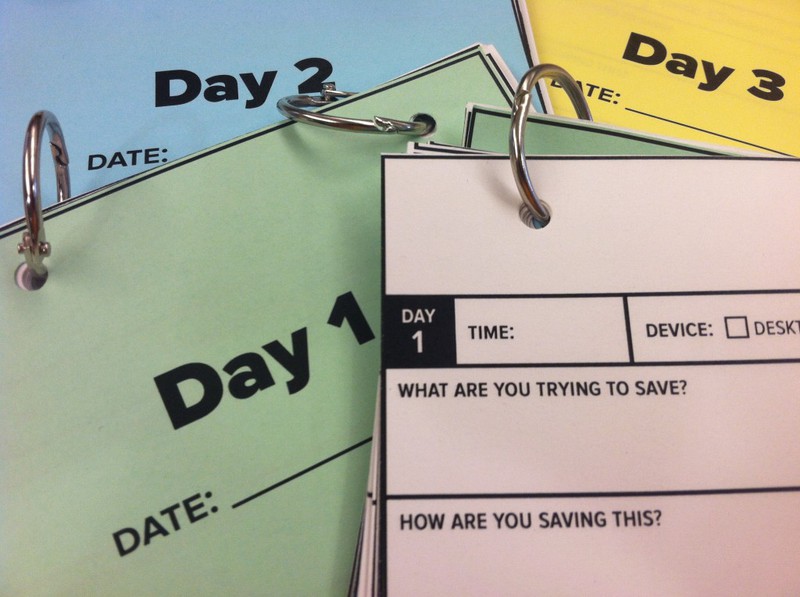
Every day, participants had to record data in response to questions:
Day 1. Saving: what and why do you want to save? How do you save normally?
Day 2. Re-visit: which sites and why are you visiting again? What did you do about it?
Day 3. Depriving of bookmarks: describe your actions in the absence of the bookmarks function.
One of the researchers showed me an application that he uses to save bookmarks:
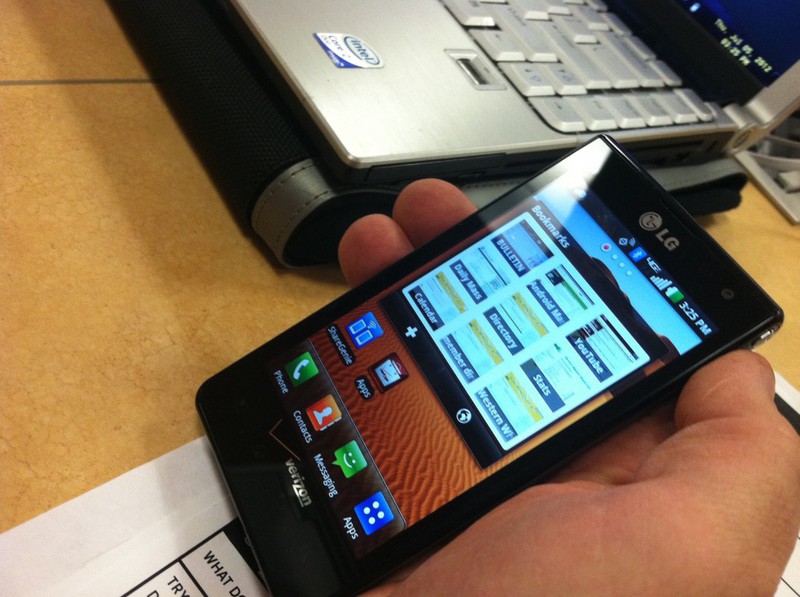
Three days later, the study participants came for an interview in which I asked them to voice all their actions while working with the browser in order to better understand how a person interacts with devices.
Bookmarks on leaflets, divided into categories by the participants themselves:
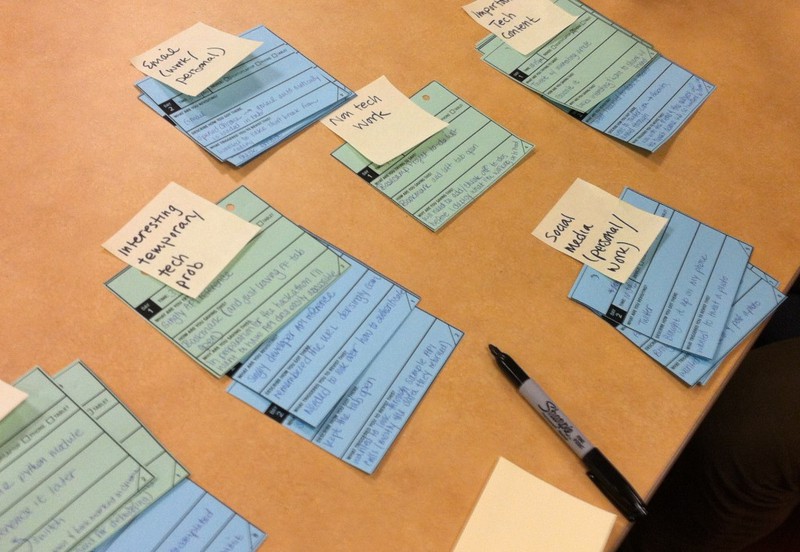
I collected all the questionnaires and summarized them, taking the basic information:
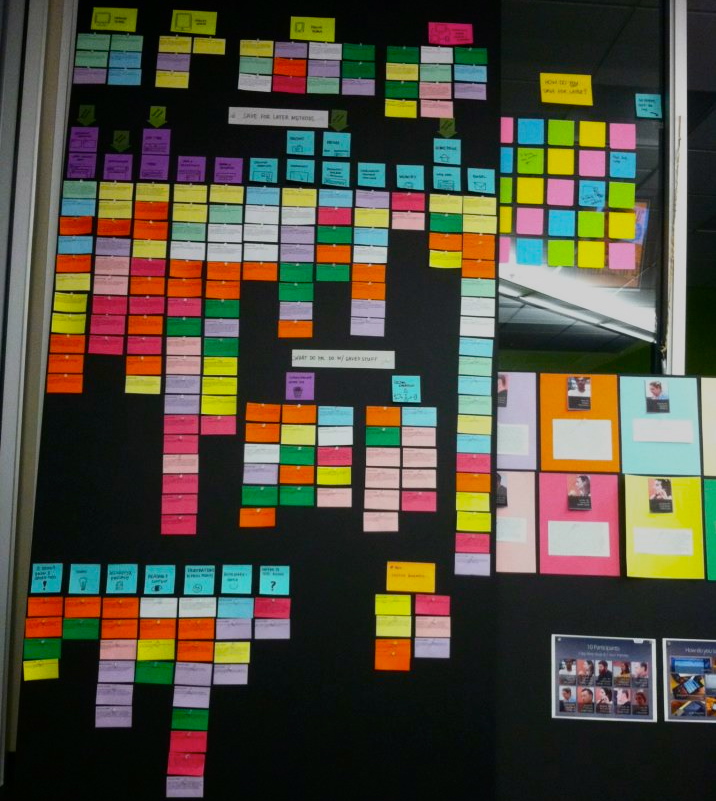
The result was a scheme where each participant is assigned a different color, and the main research data are also indicated:

As a result, it was possible to understand the basic ways of saving site content for "reading later":

Many users simply left the desired tab or window open to read the content later. I was most surprised by the use of email. almost all users sent the link to themselves to visit it later. Services used by some members:

What happens after saving the link “for later”? All actions can be divided into several categories:
1. “Consumption”: after using the content (reading or viewing), it becomes unnecessary, so it is simply deleted.
2. Reuse: dynamic content (for example, updatable sites) is used repeatedly.
3. Sharing: user sharing content while keeping it.
4. Unclear use: preserving content that may someday come in handy.
5. Organization: the preservation of content to streamline existing, as well as communication with him.
6. Cleaning: saving and deleting content.
An interesting analogy is the preservation of content with the workplace:
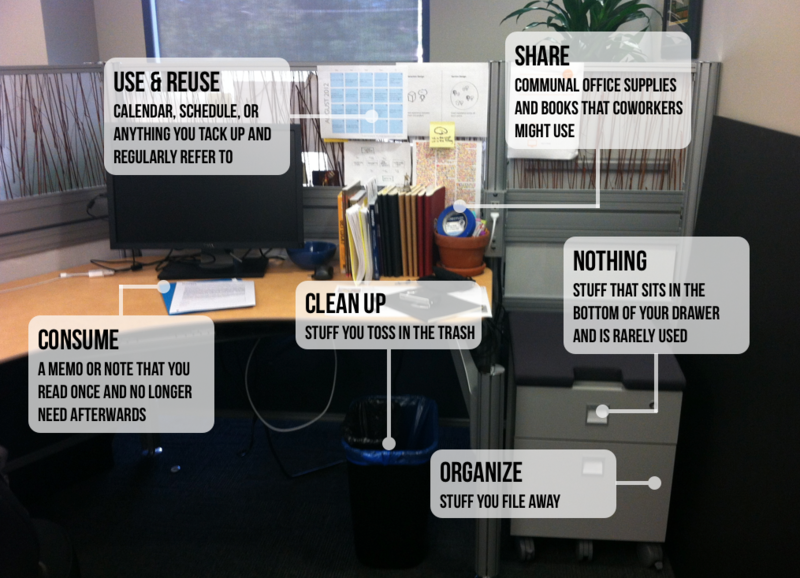
Separation and popularity of categories on different devices:

Thanks to Test Pilot, we learned that users quite often assign a homepage in the browser:

Ways to bookmark Firefox:
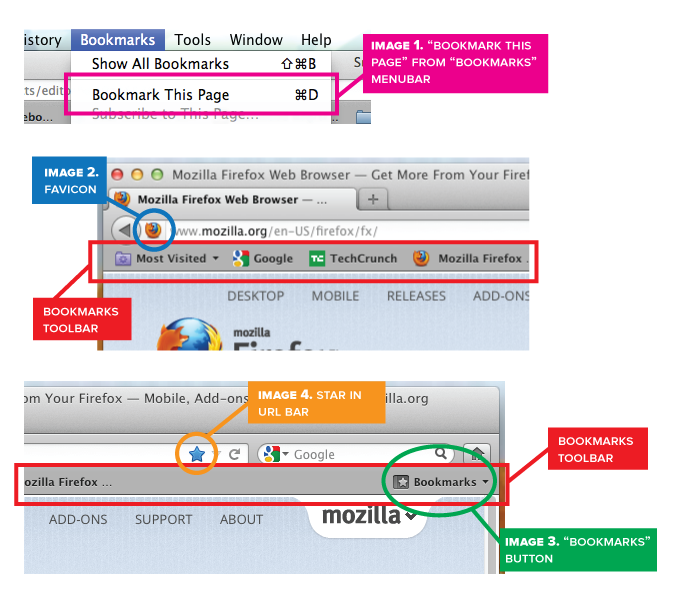
Statistics of more than 5000 users, the most popular way is to click on the asterisk.
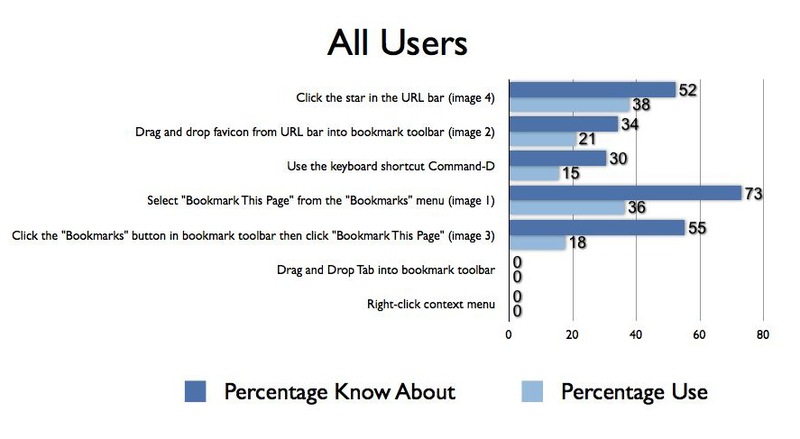
Click Map:

Mozilla brainstorming:

Based on the results of the research, I chose the main directions for developing the Save for Later feature:
1. Access from anywhere: users want access to stored content at any time and from any device.
2. Any content: users want to add any information (text, photo, video) without unnecessary garbage in the form of interface sites.
3. Reliability. Users want to have a reliable repository of their content.
4. Versatility: users save content that can be used later on as they please.
Mozilla UX designers at work:

All "nazozgoshturmlennaya" was written on the board:
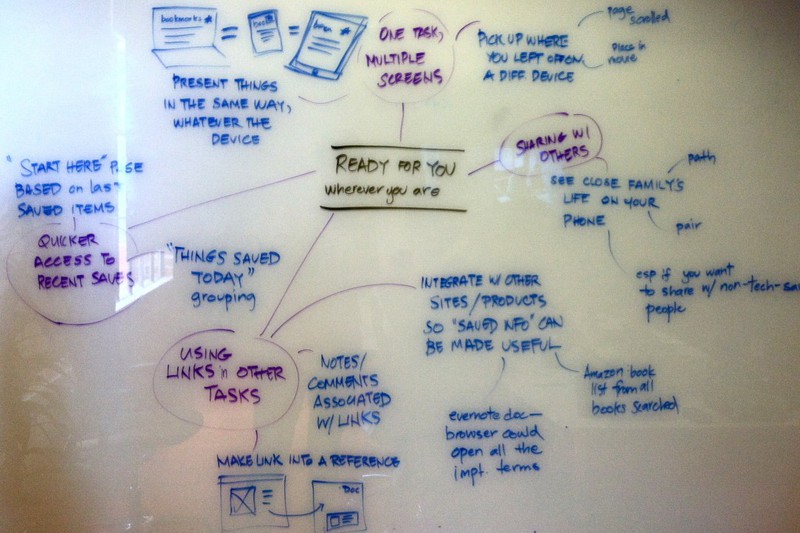

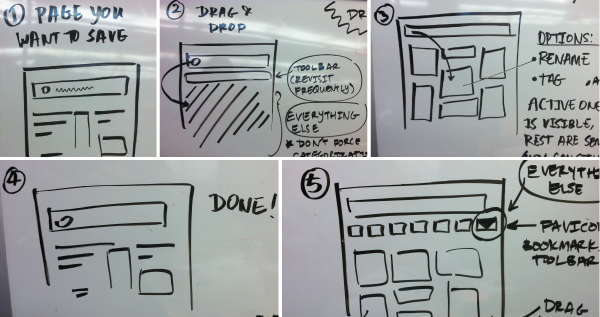
One of the ideas was Dropzilla - the ability to add sites to bookmarks by dragging and dropping onto a special “Save for Later” panel, as well as synchronize data with bookmark services:
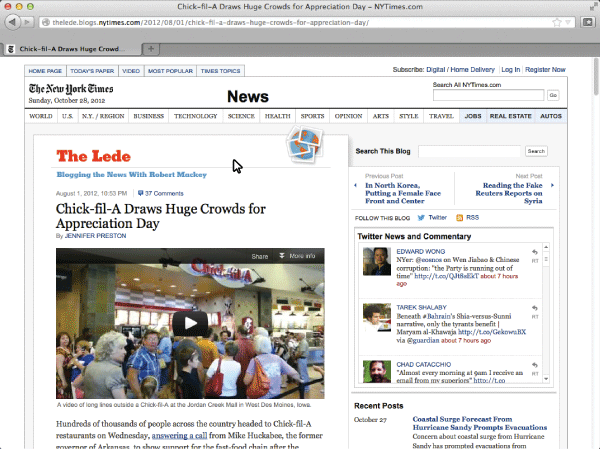
Dropzilla is just one of the concepts behind the implementation of the Save for Later feature, which was born during the brainstorming of Mozilla developers. In the course of this work, I realized the main thing: despite the sufficient standardization of browsers today, there is still room for imagination and the realization of new ideas.

Firefox and “save for later”
The browser has essentially two main functions: search (surfing) and re-visit. My task was to organize the bookmarks in such a way that the re-visit was the most simple and convenient. In developing the Save for Later feature, I worked closely with the Mozilla team, including front-end developers and product managers. 9 week development schedule:
')

Initially, a request for research from Firefox came to the Android team: why bookmarks are rarely used on mobile devices, and how much the popularity of this feature has grown, if it was implemented differently.

After a close look at the bookmarks in Firefox, it was clear that the function was implemented too difficult and should be simplified. It was also important to understand what today means “bookmark” for the user, and what options he would like to see.

As a result, it was concluded that the main purpose of the bookmarks is the function “Read later”.
Research phase
Of the 60 people, 10 were selected to participate in the study. All were asked profiles:

Every day, participants had to record data in response to questions:
Day 1. Saving: what and why do you want to save? How do you save normally?
Day 2. Re-visit: which sites and why are you visiting again? What did you do about it?
Day 3. Depriving of bookmarks: describe your actions in the absence of the bookmarks function.
One of the researchers showed me an application that he uses to save bookmarks:

Three days later, the study participants came for an interview in which I asked them to voice all their actions while working with the browser in order to better understand how a person interacts with devices.
Bookmarks on leaflets, divided into categories by the participants themselves:

Generalization
I collected all the questionnaires and summarized them, taking the basic information:

The result was a scheme where each participant is assigned a different color, and the main research data are also indicated:

As a result, it was possible to understand the basic ways of saving site content for "reading later":

Many users simply left the desired tab or window open to read the content later. I was most surprised by the use of email. almost all users sent the link to themselves to visit it later. Services used by some members:

What happens after saving the link “for later”? All actions can be divided into several categories:
1. “Consumption”: after using the content (reading or viewing), it becomes unnecessary, so it is simply deleted.
2. Reuse: dynamic content (for example, updatable sites) is used repeatedly.
3. Sharing: user sharing content while keeping it.
4. Unclear use: preserving content that may someday come in handy.
5. Organization: the preservation of content to streamline existing, as well as communication with him.
6. Cleaning: saving and deleting content.
An interesting analogy is the preservation of content with the workplace:

Separation and popularity of categories on different devices:

Quantitative analysis
Thanks to Test Pilot, we learned that users quite often assign a homepage in the browser:

Ways to bookmark Firefox:

Statistics of more than 5000 users, the most popular way is to click on the asterisk.

Click Map:

Mozilla brainstorming:

Based on the results of the research, I chose the main directions for developing the Save for Later feature:
1. Access from anywhere: users want access to stored content at any time and from any device.
2. Any content: users want to add any information (text, photo, video) without unnecessary garbage in the form of interface sites.
3. Reliability. Users want to have a reliable repository of their content.
4. Versatility: users save content that can be used later on as they please.
Mozilla UX designers at work:

All "nazozgoshturmlennaya" was written on the board:



One of the ideas was Dropzilla - the ability to add sites to bookmarks by dragging and dropping onto a special “Save for Later” panel, as well as synchronize data with bookmark services:

Dropzilla is just one of the concepts behind the implementation of the Save for Later feature, which was born during the brainstorming of Mozilla developers. In the course of this work, I realized the main thing: despite the sufficient standardization of browsers today, there is still room for imagination and the realization of new ideas.
Source: https://habr.com/ru/post/158987/
All Articles